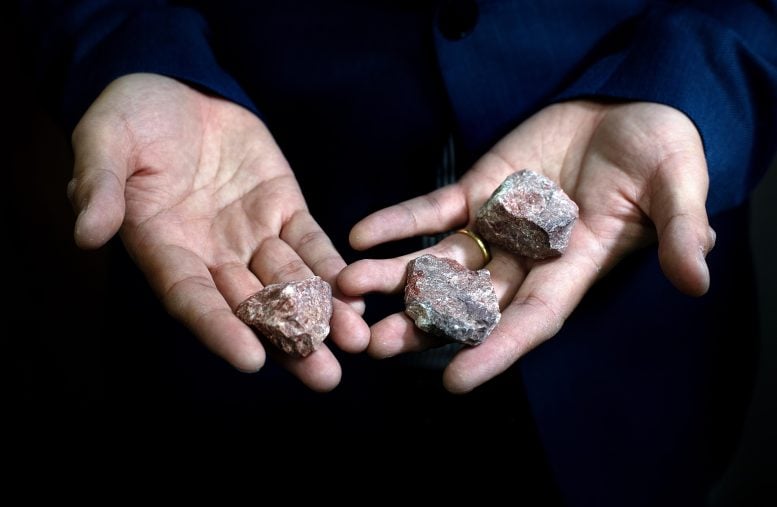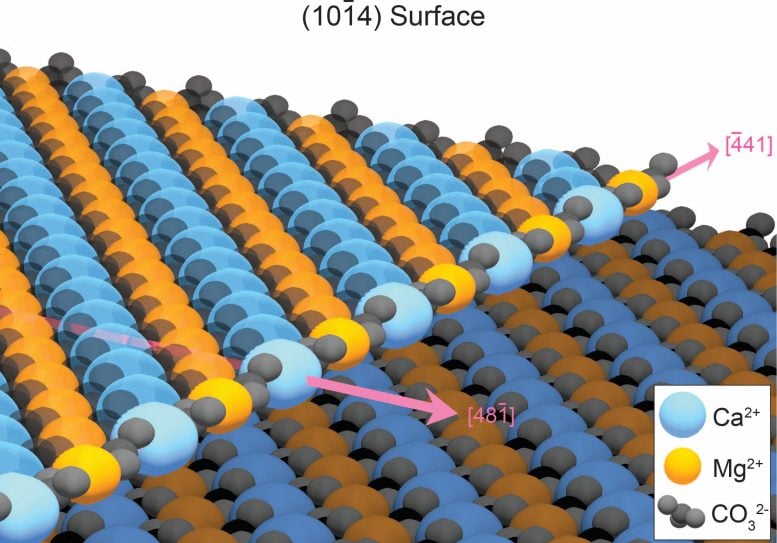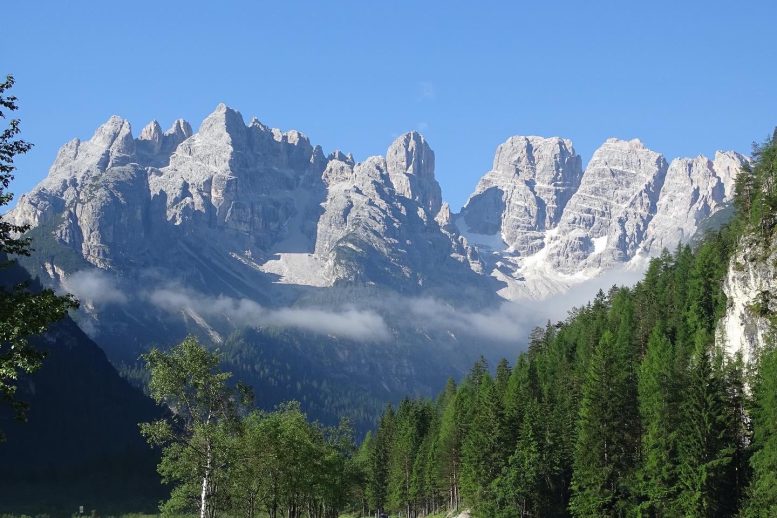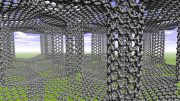
Professor Wenhao Sun shows off dolomite from his personal rock collection. Sun studies crystal growth of minerals from a materials science perspective. By understanding how atoms come together to form natural minerals, he believes we can reveal fundamental mechanisms of crystal growth, which can be used to make functional materials more quickly and efficiently. Credit: Marcin Szczepanski, Lead Multimedia Storyteller, Michigan Engineering.
To create mountains from dolomite, a common mineral, it must periodically dissolve. This seemingly paradoxical concept could help make new defect-free semiconductors and more.
For two centuries, scientists have failed to grow a common mineral in the laboratory under the conditions believed to have formed it naturally. Now, a team of researchers from the University of Michigan and Hokkaido University in Sapporo, Japan have finally pulled it off, thanks to a new theory developed from atomic simulations.
Their success resolves a long-standing geology mystery called the “Dolomite Problem.” Dolomite—a key mineral in the Dolomite mountains in Italy, Niagara Falls, and Utah’s Hoodoos—is very abundant in rocks older than 100 million years, but nearly absent in younger formations.

Wenhao Sun, Dow Early Career Assistant Professor of Materials Science and Engineering at the University of Michigan, and Joonsoo Kim, a doctoral student of materials science and engineering in Professor Sun’s research group, show off dolomite rocks from their lab’s collection. The two scientists have developed a theory that could finally explain a two-century old puzzle surrounding dolomite’s abundance on Earth. Credit: Marcin Szczepanski, Lead Multimedia Storyteller, Michigan Engineering.
The Importance of Understanding Dolomite Growth
“If we understand how dolomite grows in nature, we might learn new strategies to promote the crystal growth of modern technological materials,” said Wenhao Sun, the Dow Early Career Professor of Materials Science and Engineering at U-M and the corresponding author of the paper recently published in Science.
The secret to finally growing dolomite in the lab was removing defects in the mineral structure as it grows. When minerals form in water, atoms usually deposit neatly onto an edge of the growing crystal surface. However, the growth edge of dolomite consists of alternating rows of calcium and magnesium. In water, calcium and magnesium will randomly attach to the growing dolomite crystal, often lodging into the wrong spot and creating defects that prevent additional layers of dolomite from forming. This disorder slows dolomite growth to a crawl, meaning it would take 10 million years to make just one layer of ordered dolomite.

The structure of a dolomite crystal edge. Rows of magnesium (orange spheres) alternate with rows of calcium (blue spheres), and are interspersed with carbonate (black structures). The pink arrows show the directions of crystal growth. Calcium and magnesium often attach to the growth edge improperly, which stops dolomite growth. Credit: Joonsoo Kim, doctoral student, materials science and engineering, University of Michigan.
Luckily, these defects aren’t locked in place. Because the disordered atoms are less stable than atoms in the correct position, they are the first to dissolve when the mineral is washed with water. Repeatedly rinsing away these defects—for example, with rain or tidal cycles—allows a dolomite layer to form in only a matter of years. Over geologic time, mountains of dolomite can accumulate.
Advanced Simulation Techniques
To simulate dolomite growth accurately, the researchers needed to calculate how strongly or loosely atoms will attach to an existing dolomite surface. The most accurate simulations require the energy of every single interaction between electrons and atoms in the growing crystal. Such exhaustive calculations usually require huge amounts of computing power, but software developed at U-M’s Predictive Structure Materials Science (PRISMS) Center offered a shortcut.
“Our software calculates the energy for some atomic arrangements, then extrapolates to predict the energies for other arrangements based on the symmetry of the crystal structure,” said Brian Puchala, one of the software’s lead developers and an associate research scientist in U-M’s Department of Materials Science and Engineering.
That shortcut made it feasible to simulate dolomite growth over geologic timescales.

Dolomite is a mineral so common in ancient rocks that it forms mountains like this namesake mountain range in northern Italy. But dolomite is rare in younger rocks and could not be made in the lab under the conditions at which it formed naturally. A new theory helped scientists grow the mineral in the lab at ordinary temperature and pressure for the first time and could help explain the scarcity of dolomite in younger rocks. Photo credit: Francesca.z73 via Wikimedia Commons.
“Each atomic step would normally take over 5,000 CPU hours on a supercomputer. Now, we can do the same calculation in 2 milliseconds on a desktop,” said Joonsoo Kim, a doctoral student of materials science and engineering and the study’s first author.
Practical Application and Testing of the Theory
The few areas where dolomite forms today intermittently flood and later dry out, which aligns well with Sun and Kim’s theory. But such evidence alone wasn’t enough to be fully convincing. Enter Yuki Kimura, a professor of materials science from Hokkaido University, and Tomoya Yamazaki, a postdoctoral researcher in Kimura’s lab. They tested the new theory with a quirk of transmission electron microscopes.
“Electron microscopes usually use electron beams just to image samples,” Kimura said. “However, the beam can also split water, which makes acid that can cause crystals to dissolve. Usually, this is bad for imaging, but in this case, dissolution is exactly what we wanted.”
After placing a tiny dolomite crystal in a solution of calcium and magnesium, Kimura and Yamazaki gently pulsed the electron beam 4,000 times over two hours, dissolving away the defects. After the pulses, dolomite was seen to grow approximately 100 nanometers—around 250,000 times smaller than an inch. Although this was only 300 layers of dolomite, never had more than five layers of dolomite been grown in the lab before.
The lessons learned from the Dolomite Problem can help engineers manufacture higher-quality materials for semiconductors, solar panels, batteries, and other tech.
“In the past, crystal growers who wanted to make materials without defects would try to grow them really slowly,” Sun said. “Our theory shows that you can grow defect-free materials quickly, if you periodically dissolve the defects away during growth.”
Reference: “Dissolution enables dolomite crystal growth near ambient conditions” by Joonsoo Kim, Yuki Kimura, Brian Puchala, Tomoya Yamazaki, Udo Becker and Wenhao Sun, 23 November 2023, Science.
DOI: 10.1126/science.adi3690
The research was funded by the American Chemical Society PRF New Doctoral Investigator grant, the U.S. Department of Energy, and the Japanese Society for the Promotion of Science.









So the seasonal rain can make it happen in the naturally? Still needs impurities not to contaminate large areas during each rain soaking? Seems like a tall order in the real world.
I’m not sure that the ‘problem’ has been solved. Their research suggests that pure dolomite should only be found on the surface of exposed rocks, not in the interior. Also, as I recollect, there is an associated problem of the abundance of magnesium.
Since when were the White Cliffs of Dover made of Dolomite! They are chalk – coccolithophores and black flint. As I test I put the question to the internet and the first box that comes up also says the white cliffs of Dover are dolomite. I’m wondering who gleaned that false information from who?
Hi Lynn,
Thank you for the comment; we appreciate your feedback. The article has been corrected. The original author had confused the Cliffs of Dover with a different feature.
Since when were the White Cliffs of Dover made of Dolomite! They are chalk – coccolithophores and black flint.
This artricle leaves a lot of questions. Also simulations have proven to be unreliable. Nature never provides for laboratory conditions and it appears that the simulations were run with laboratory specifications.